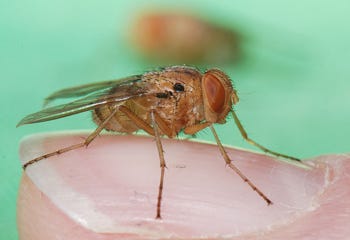Creating Fly-Inspired Hearing Aid Technology
July 23, 2014
Muhammad Ali famously described his boxing style as, "Float like a butterfly, sting like a bee."
|
The fly Ormia ochracea. Photo courtesy of Jpaur. Own work. Licensed under Creative Commons Attribution. |
Well, how about, "Hear like a fly?"
Researchers Michael A. Kuntzman and Neal A. Hall of the Department of Electrical and Computer Engineering at The University of Texas at Austin write in Applied Physics Letters that they have built a hearing mechanism prototype that mimics the hearing abilities of Ormia ochracea, a parasitoid fly with amazing abilities to locate a male cricket via its chirping.
Kuntzman and Hall's work may help human hearing aids block out background noise, a reason many refuse to wear them.
The fly uses two modes of vibration to amplify time and level distances, allowing it to detect the direction of sound well beyond its apparent capability to hear, according to the research article. Kuntzman and Hall have been using biomimicry to design tiny microphones with the same capabilities.
A silicon-micromachined prototype of the microphone uses multiple sensing ports to make different sound directivity patterns available simultaneously. It can also compute, with a single sensing structure, the angle of a sound.
The fly research is only the latest example of medtech researchers turning to nature for answers when it comes to improving human beings' health.
Carnegie Mellon researchers found that naturally occurring melanins derived from cuttlefish ink provide the right chemistry and nanostructure to power tiny, ingested electronic devices. In humans, this might allow arthritis and osteoarthritis patients to take pills, normally destroyed by stomach acid, instead of injections to treat their disease. A smart device might usher the pill to the intestine for digestion rather than in the stomach.
A team of scientists at the University of Massachusetts (UMass) has developed a reusable adhesive inspired by the adhesive toe pads of geckos that enable them to climb up walls. Geckskin is made from nylon, bathroom caulking, and carbon fiber or cotton. Commercial applications are about a year away. It will be interesting to see how the adhesive might be used in a medical environment.
Refresh your medical device industry knowledge at MEDevice San Diego, September 10-11, 2014. |
University of Akron (UA; OH) polymer scientists have meanwhile created synthetic duplicates of patterns used by spiders when constructing webs that may lead to stronger and more efficient commercial and biomedical adhesives that could, for example, potentially attach tendons to bones or bind fractures.
"This adhesive architecture holds promise for potential applications in the area of adhesion science, particularly in the field of biomedicine where the cost of the materials is a significant constraint," lead author Dharamdeep Jain wrote in "Synthetic Adhesive Attachment Discs Inspired by Spider'sPyriform Silk Architecture," published recently in the Journal of Polymer Science.
Nancy Crotti is a contributor to Qmed and MPMN.
Like what you're reading? Subscribe to our daily e-newsletter.
About the Author(s)
You May Also Like



